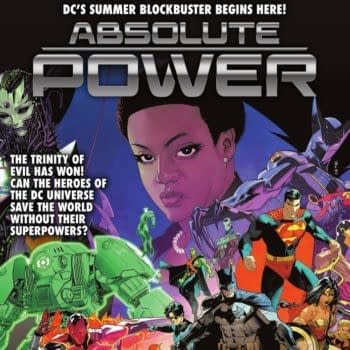Posted in: Comics | Tagged: Comics, dc, entertainment, gendercrunching, marvel
Gendercrunching by Tim Hanley – DC and Marvel, October 2011
Tim Hanley writes for Bleeding Cool;
Both publishers improved in October, with DC edging out Marvel by just 0.1% to claim the top overall percentage of female creators. DC returned to its average range, while Marvel continued their impressive autumn with a total well above their average for the year. Let's take a look at the numbers.
DC COMICS
DC put out a lot more books in October than in September, and these additional titles seem to have brought some female creators with them. In October 2011, DC Comics released 81 new comic books with 655 credited creators, 582 men and 73 women. Here are the charts:
DC went up 0.5% from their September total, and their 11.1% is pretty much as average as you can get with DC. While the New 52 made up the bulk of September's books, DC had another 8 new number ones in October, plus a couple of returning titles that had sat on the bench in September. These new books bumped up the overall percentage of female creators nicely.
By category, DC had a strong month in terms of improvement. The numbers on the creative side aren't anything massive, but cover artists, writers, pencillers, and inkers were all up by a percentage point or so from September. Colorists saw a solid jump of 4.2%, although letterers remained the same at zero. Assistant editors had a nice 3.7% gain, but editors fell a substantial 7.6%. All in all, the distribution of female creators at DC was a lot better in October, though really, the distribution couldn't have gotten much worse than September. However, with Nicola Scott on Superman #3 and a few other female creators lined up, these creative numbers might continue to grow in November.
MARVEL COMICS
I was worried that Marvel's September numbers might be a fluke and that they'd be back to single digits in October, but their overall total actually improved slightly. In October 2011, Marvel released 81 new comics featuring 636 credited creators, 566 men and 70 women, for these percentages:
A 0.1% gain isn't anything massive, but when you're used to Marvel being at about 9%, October's 11% is pretty impressive. Two well above average months in a row is encouraging to see, especially after Marvel's fairly weak summer. Hopefully these numbers will continue to grow.
The gain overall is great to see, but Marvel didn't have the best month by category. Cover artists, writers, pencillers, and inkers were all down in October, with pencillers seeing the biggest drop of 2.6%, over half of their September total. Colorists had a modest gain of 0.8% and, of course, letterers remained the same. It was a very odd month in editorial, with full editors gaining a huge 10.2% while assistant editors dropped a big 6.9%… that is some bizarre editorial instability. Altogether, Marvel's overall total was solid, but their usually strong distribution by category took a step backwards in October. A few female heavy series wrapped up in October, so it'll be interesting to see if Marvel can continue their strong numbers in November.
COMIC BOOKS VS. SCIENCE FICTION AND FANTASY NOVELS
I thought it might be interesting to look outside of the world of comics and see how women are represented in other typically male-oriented markets. Comic books probably have no closer relative than the world of science fiction and fantasy novels. We all go to conventions together, there's a lot of creator crossover, and fans of one are usually fans of the other. Plus, science fiction and fantasy are genres typically associated with a male audience. So I looked at the books put out by two of the biggest publishers today, much like we do each month with DC and Marvel, and tallied up their authors.
First up was Random House, who boast an impressive SF/fantasy line-up. For example, they put out George R.R. Martin's A Dance with Dragons, along with Naomi Novik's Temeraire series, Diana Gabaldon's Outlander books, and Terry Brooks' Shannara epic. On top of all of this, they also have the Star Wars license and put out 14 Star Wars novels last year. Coincidentally, Random House published the DC novel It's Superman! as well.
Next was Simon & Schuster, who are very prolific but feature a less well known product line than Random House, focusing more on smaller series and video game adaptations. They do, however, have novels by several comic book writers, including Dan Abnett, Karen Traviss, Peter David, and Si Spurrier. Simon & Schuster also has the Star Trek license, and released 17 Star Trek novels last year. In another amusing coincidence, they published an adaptation of Marvel's Ultimates comics, The Ultimates: Against All Enemies.
The methodology for this was pretty simple. I picked Random House and Simon & Schuster because they are two big companies with a different product focus. Plus, I really liked the Star Wars vs. Star Trek thing. The Superman/Ultimates connection was totally accidental, but fun. I went through both publishers' entire SF/fantasy book list for 2011, and listed every book they printed (it had to be an actual book… both companies seemed to be updating their e-book catalogue regularly with older books, but I focused on books that were physically published in 2011), then tallied up the number of authors by gender.
For the full calendar year of 2011, Random House published 138 SF/fantasy novels with 147 credited authors, 102 men and 45 women. Simon & Schuster put out 176 SF/fantasy novels featuring 194 credited authors, 143 men and 51 women. Here are their percentages against the percentage of writers at DC and Marvel for the entire year thus far:
So there's a bit of a difference there. DC's 3.2% women and Marvel's 6.3% are dwarfed by Random House's 30.6% and Simon & Schuster's 26.4%. The average for comic books is 4.8%, while the average for the novels is 28.5%, or almost SIX times more. For two industries that have so much in common, they are on completely different pages when it comes to women writing their material. This is a bizarre divide, to say the least.
However, Random House and Simon & Schuster publish a wide array of SF/fantasy novels, while DC and Marvel mostly just do superheroes. Several of the novels I looked at appeared to be aimed at more of a female audience, and there were a lot of female writers on those sorts of books. The closest thing Random House and Simon & Schuster had to superheroes were their Star Wars and Star Trek lines… much like superheroes, Star Wars and Star Trek have a rabid male fanbase, and Superman and Wolverine have a lot in common with Han Solo and Captain Kirk in terms of being cultural icons that are carefully maintained by the massive entities who own them. So I decided to compare those.
For the full calendar year of 2011, Random House published 14 Star Wars novels with 16 credited authors, 13 men and 3 women. Simon & Schuster put out 17 Star Trek novels featuring 23 credited authors, 19 men and 4 women. Here's how they stack up:
So things look a little better for comics, but not a whole lot. The comic book average is still 4.8%, and Star Wars and Star Trek have a combined average of 18.1%, or almost FOUR times more. This is still a considerable gap. These publishers all put out printed stories about the continuing fantastical adventures of characters created decades ago, yet there is a huge divide between comics and novels in terms of female writers. All of the arguments for why there aren't many women making comics SHOULD apply to science fiction and fantasy as well, but lots of ladies are writing these novels. Something seems odd in the comic book world.
Incidentally, DC and Marvel editors, I now have a long list of female science fiction and fantasy writers, if you happen to be looking for some.
To learn more about this statistics project and its methodology click here, and to see the previous stats click here. If you want to see full spreadsheets and data for any of the stats discussed above, please contact Tim.
You can visit Tim at Straitened Circumstances and follow him on Twitter @timhanley01.















